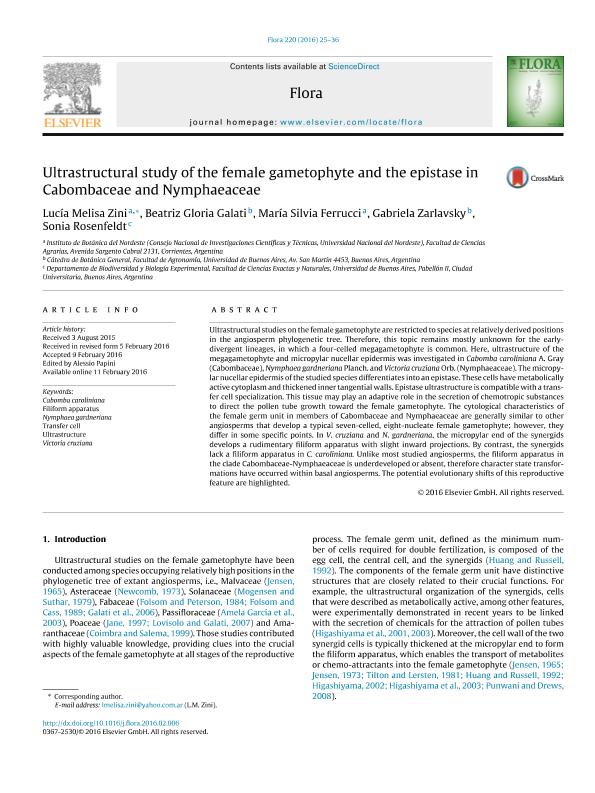Artículo
Ultrastructural study of the female gametophyte and the epistase in Cabombaceae and Nymphaeaceae
Zini, Lucia Melisa ; Galati, Beatriz Gloria; Ferrucci, María Silvia
; Galati, Beatriz Gloria; Ferrucci, María Silvia ; Zarlavsky, Gabriela Elena; Rosenfeldt, Sonia
; Zarlavsky, Gabriela Elena; Rosenfeldt, Sonia
 ; Galati, Beatriz Gloria; Ferrucci, María Silvia
; Galati, Beatriz Gloria; Ferrucci, María Silvia ; Zarlavsky, Gabriela Elena; Rosenfeldt, Sonia
; Zarlavsky, Gabriela Elena; Rosenfeldt, Sonia
Fecha de publicación:
02/2016
Editorial:
Elsevier Gmbh
Revista:
Flora
ISSN:
0367-2530
Idioma:
Inglés
Tipo de recurso:
Artículo publicado
Clasificación temática:
Resumen
Ultrastructural studies on the female gametophyte are restricted to species at relatively derived positionsin the angiosperm phylogenetic tree. Therefore, this topic remains mostly unknown for the early-divergent lineages, in which a four-celled megagametophyte is common. Here, ultrastructure of themegagametophyte and micropylar nucellar epidermis was investigated in Cabomba caroliniana A. Gray(Cabombaceae), Nymphaea gardneriana Planch. and Victoria cruziana Orb. (Nymphaeaceae). The micropy-lar nucellar epidermis of the studied species differentiates into an epistase. These cells have metabolicallyactive cytoplasm and thickened inner tangential walls. Epistase ultrastructure is compatible with a trans-fer cell specialization. This tissue may play an adaptive role in the secretion of chemotropic substancesto direct the pollen tube growth toward the female gametophyte. The cytological characteristics ofthe female germ unit in members of Cabombaceae and Nymphaeaceae are generally similar to otherangiosperms that develop a typical seven-celled, eight-nucleate female gametophyte; however, theydiffer in some specific points. In V. cruziana and N. gardneriana, the micropylar end of the synergidsdevelops a rudimentary filiform apparatus with slight inward projections. By contrast, the synergidslack a filiform apparatus in C. caroliniana. Unlike most studied angiosperms, the filiform apparatus inthe clade Cabombaceae-Nymphaeaceae is underdeveloped or absent, therefore character state transfor-mations have occurred within basal angiosperms. The potential evolutionary shifts of this reproductivefeature are highlighted.
Palabras clave:
Cabomba Caroliniana
,
Filiform Apparatus
,
Nymphaea Gardneriana
,
Transfer Cell
Archivos asociados
Licencia
Identificadores
Colecciones
Articulos(IBONE)
Articulos de INST.DE BOTANICA DEL NORDESTE (I)
Articulos de INST.DE BOTANICA DEL NORDESTE (I)
Citación
Zini, Lucia Melisa; Galati, Beatriz Gloria; Ferrucci, María Silvia; Zarlavsky, Gabriela Elena; Rosenfeldt, Sonia; Ultrastructural study of the female gametophyte and the epistase in Cabombaceae and Nymphaeaceae; Elsevier Gmbh; Flora; 220; 2-2016; 25-36
Compartir
Altmétricas



